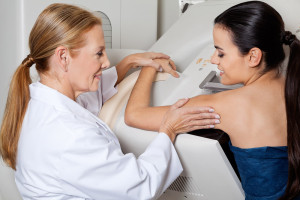Svahn, T.M. et al. The Breast 2014, Dec 29.
We examined how radiation dose levels in digital breast tomosynthesis (DBT) differ from those used in 2-view full-field digital mammography (FFDM).
Acquisition parameter settings and information on the average absorbed dose to the glandular tissues within the breasts were reviewed based on clinical studies that evaluated DBT and FFDM. Dose ratios (DDBT/DFFDM) were derived from imaging protocols, which included tomosynthesis in 1- or 2-views alone, and as an adjunct technique to FFDM.
Stand-alone DBT was associated with a much lower to a slightly higher radiation dose compared to that of comparable FFDM units, as summarized in dose ratio ranges of 0.34–1.0 for 1-view DBT, and 0.68–1.17 for 2-view DBT. One of the lowest reported dose estimates was obtained using a photon-counting DBT unit (avg. 0.70 mGy/scan; range: 0.28–1.26 mGy). Breast doses for DBT combined with FFDM are summarized in dose ratio ranges of 1.03–1.5 for 1-view DBT plus FFDM, and 2.0–2.23 for 2-view DBT plus FFDM. In the latter of these settings, the dose was reduced by ∼45% when 2D-views, reconstructed from the DBT images (“synthetic 2D images”), were used as a substitute for FFDM.
Stand-alone DBT operated at lower to slightly higher radiation doses in comparison to FFDM. For DBT combined with FFDM, radiation doses were elevated, at maximum by a factor ∼2 1/4 of that of FFDM alone. In this setting, a replacement of FFDM with synthetic 2D-views reduced the breast dose approximately by half, which has substantial implications for population screening programs.
Abstract (c) Elsevier. Original here.
Comments:
Compared with FFDM, DBT has been shown to increase breast cancer detection rates by 10% to 53% and to reduce recall rates by 20% to 59%. This is important when assessing the doses of radiation of one versus another protocol. Thus tomosynthesis can both reduce dose and improve outcome, best summarized by Dr. Anders Tingberg.
“Careful justification is needed every time a new modality or imaging technique is to replace an old one,” Dr. Tingberg* said. “Do the benefits from the new modality outweigh the disadvantages associated with it? In my opinion, tomosynthesis used with optimum exposure settings could be an alternative or in some cases even replace mammography for breast cancer screening.”
*Dr. Anders Tingberg from Skane University Hospital, Malmo, Sweden. Quote from Healthy Living Magazine.
More about breast tomosynthesis:
At wikipedia or from one of the leading suppliers.
